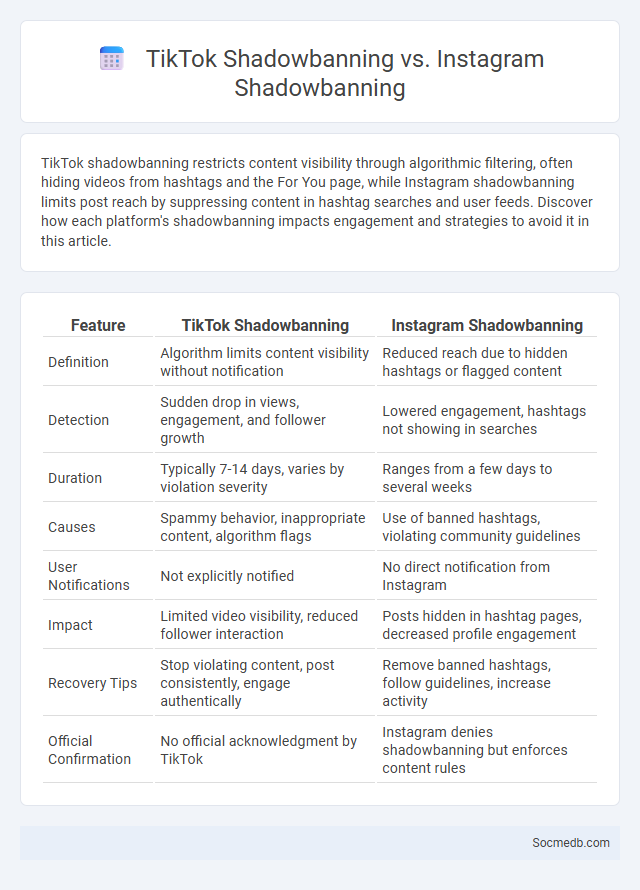
Photo illustration: TikTok Shadowbanning vs Instagram Shadowbanning
TikTok shadowbanning restricts content visibility through algorithmic filtering, often hiding videos from hashtags and the For You page, while Instagram shadowbanning limits post reach by suppressing content in hashtag searches and user feeds. Discover how each platform's shadowbanning impacts engagement and strategies to avoid it in this article.
Table of Comparison
| Feature | TikTok Shadowbanning | Instagram Shadowbanning |
|---|---|---|
| Definition | Algorithm limits content visibility without notification | Reduced reach due to hidden hashtags or flagged content |
| Detection | Sudden drop in views, engagement, and follower growth | Lowered engagement, hashtags not showing in searches |
| Duration | Typically 7-14 days, varies by violation severity | Ranges from a few days to several weeks |
| Causes | Spammy behavior, inappropriate content, algorithm flags | Use of banned hashtags, violating community guidelines |
| User Notifications | Not explicitly notified | No direct notification from Instagram |
| Impact | Limited video visibility, reduced follower interaction | Posts hidden in hashtag pages, decreased profile engagement |
| Recovery Tips | Stop violating content, post consistently, engage authentically | Remove banned hashtags, follow guidelines, increase activity |
| Official Confirmation | No official acknowledgment by TikTok | Instagram denies shadowbanning but enforces content rules |
Understanding Shadowbanning: What It Means on Social Platforms
Shadowbanning on social media refers to the practice where a user's content is partially or fully hidden without notification, limiting its visibility to others. This tactic is often used to combat spam, misinformation, or policy violations, affecting platforms like Instagram, Twitter, and TikTok. Understanding shadowbanning involves recognizing reduced engagement, search exclusion, and diminished reach as common indicators.
How TikTok Shadowbanning Works: Signs and Causes
TikTok shadowbanning occurs when the platform restricts a user's content visibility without notification, significantly reducing video reach and engagement. Common signs include a sudden drop in views, reduced follower growth, and poor performance in the For You page algorithm. Causes often involve violations of TikTok's community guidelines, repetitive content, or algorithmic detection of suspicious activity such as spammy behavior or inappropriate hashtags.
Instagram Shadowbanning: Mechanisms and User Impact
Instagram shadowbanning restricts the visibility of your posts without explicit notification, primarily triggered by the use of banned hashtags, spam-like behaviors, or policy violations. This algorithmic suppression reduces engagement rates and limits your audience reach, impacting content discoverability and user growth. Understanding shadowbanning mechanisms helps you adapt posting strategies to maintain account health and optimize social media presence.
Algorithmic Bias: Definition and Relevance in Social Media
Algorithmic bias in social media refers to systematic favoritism or discrimination embedded within platform algorithms that influence content visibility and user interactions. These biases arise from skewed training data, design choices, or feedback loops, resulting in unequal representation of voices and potentially reinforcing stereotypes or misinformation. Recognizing and addressing algorithmic bias is crucial for promoting fairness, diversity, and transparency across major social platforms like Facebook, Twitter, and Instagram.
Key Differences Between TikTok and Instagram Shadowbanning
TikTok shadowbanning primarily targets content visibility by limiting video exposure on the "For You" page, while Instagram shadowbanning reduces hashtag reach and story distribution. TikTok's algorithmic approach focuses on video engagement metrics, whereas Instagram emphasizes community guidelines violations and spam detection. Both platforms rely on automated systems, but TikTok tends to enforce shadowbanning more transparently through notification, unlike Instagram's often opaque restrictions.
Common Triggers for Shadowbanning on Both Platforms
Common triggers for shadowbanning on social media platforms include frequent use of banned hashtags, rapid follower growth that appears unnatural, and posting repetitive or spam-like content. Engaging in aggressive follow/unfollow tactics, excessive posting in short time frames, and violating community guidelines related to hate speech or misinformation can also prompt shadowbanning. Both Instagram and TikTok employ algorithms that detect these behaviors to limit content visibility and control platform integrity.
The Role of Algorithms in Content Visibility
Social media algorithms analyze user behavior and preferences to prioritize and display content that matches individual interests, ensuring maximum engagement. These algorithms influence the visibility of posts by determining which content appears in your feed, often favoring personalized and timely updates. Understanding how algorithms work can help you optimize your content strategy to increase reach and impact.
How Algorithmic Bias Influences Shadowbanning
Algorithmic bias in social media platforms often leads to shadowbanning by disproportionately targeting content from specific groups or topics, limiting their visibility without explicit notification. Machine learning models trained on skewed data sets amplify existing prejudices, causing certain voices to be suppressed unintentionally. This covert censorship affects user engagement and perpetuates unequal information dissemination across networks like Twitter, Instagram, and Facebook.
User Strategies to Avoid Shadowbanning on TikTok and Instagram
To avoid shadowbanning on TikTok and Instagram, your content should consistently follow platform guidelines, avoiding banned hashtags and spammy behaviors like excessive liking or commenting in short periods. Engaging authentically by encouraging genuine interactions and diversifying your posts helps algorithms recognize your account as trustworthy. Regularly updating your app and monitoring account analytics can alert you to any drops in reach, enabling proactive adjustments to your user strategy.
Future of Social Media: Addressing Shadowbans and Algorithmic Fairness
Future social media platforms must prioritize transparency in algorithmic decision-making to address concerns over shadowbans and ensure algorithmic fairness. Implementing AI-driven auditing tools can help detect biased content moderation and promote equitable visibility for diverse user-generated content. Enhancing user control over content recommendations will foster trust and mitigate the adverse effects of covert censorship practices.
 socmedb.com
socmedb.com